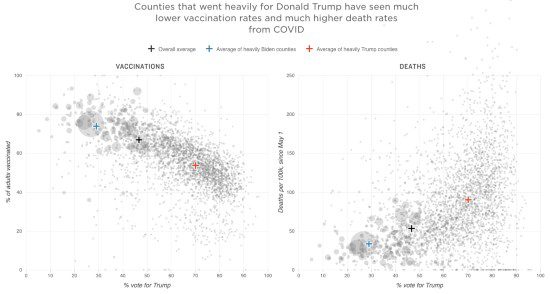To fully appreciate the stark, ugly cynicism of the 21st-century Republican Party, you have to consider the math behind stories like this one: “Pro-Trump counties now have far higher COVID death rates.”
Since May 2021, people living in counties that voted heavily for Donald Trump during the last presidential election have been nearly three times as likely to die from COVID-19 as those who live in areas that went for now-President Biden. …
People living in counties that went 60% or higher for Trump in November 2020 had 2.7 times the death rates of those that went for Biden. Counties with an even higher share of the vote for Trump saw higher COVID-19 mortality rates.
The trend was robust, even when controlling for age, which is the primary demographic risk of COVID-19 mortality. The data also reveal a major contributing factor to the death rate difference: The higher the vote share for Trump, the lower the vaccination rate.
The analysis only looked at the geographic location of COVID-19 deaths. The exact political views of each person taken by the disease remains unknowable. But the strength of the association, combined with polling information about vaccination, strongly suggests that Republicans are being disproportionately affected.
This was an entirely predictable and entirely expected consequence of the decision by Republican Party leaders to politicize public health, vaccination, and the reality of the pandemic itself. Those leaders themselves are not at greater risk of illness and death because they are, personally and privately, fully vaccinated and abiding by all the prudent precautions they’re daily encouraging their followers and supporters to ignore.
Republican Party leaders are betting that the political advantage of turning the noncontroversial matter of common-sense public health into a hot-button wedge issue will outweigh the disadvantage this strategy involves. They are, in other words, doing the arithmetic of cost-benefit analysis. The electoral benefit, they imagine, is that anti-vaccination propaganda will fire up the base, ensuring a reliable high turnout of their most loyal voters. The cost, of course, is that some percentage of those voters won’t be able to vote in the next election because they’ll be dead.
But the Republican Party has crunched the numbers here and concluded that the likely upside outweighs the inevitable downside — that the increase in voter enthusiasm and intensity prompted by their anti-vaxx crusade adds up to a greater effect than the decrease in the number of still-living Republicans able to cast votes.
They know that what they’re doing will kill tens of thousands of their own party members, but they’re calculating that the missing votes of all those dead Republicans won’t outweigh the potential advantage of increased anger and resentment that can be channeled into electoral victory and/or chaotic gridlock. And the only concern in this calculation — the only value ascribed to the lives and deaths of their own supporters — is this relative plus-or-minus with regard to their own personal political advantage.
If covid were somewhat deadlier, killing a slightly higher percentage of Republicans misled by the party’s anti-vax propaganda, the numbers might still work out in what they view as their favor. And even then people like Ted Cruz and Mitch McConnell and Kevin McCarthy and Tucker Carlson would say, “How many dead? That’s still acceptable — let’s keep doing this.”
We can surmise, in theory, that the emergence of a far-deadlier strain of covid might produce a death rate among Republican voters that Republican leaders would calculate as too costly. And at that point, in theory, Cruz, McConnell, McCarthy, et. al., might seek some way to pivot back toward support for common-sense public health measures and vaccination campaigns. But from their perspective, this would not be due to the loss of lives, only to the potential loss of votes.













